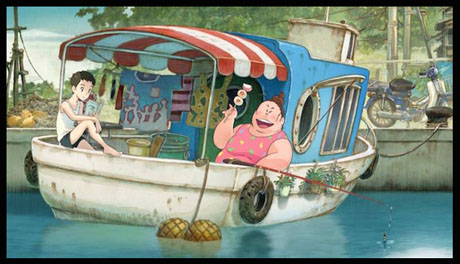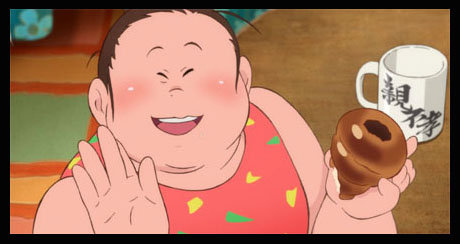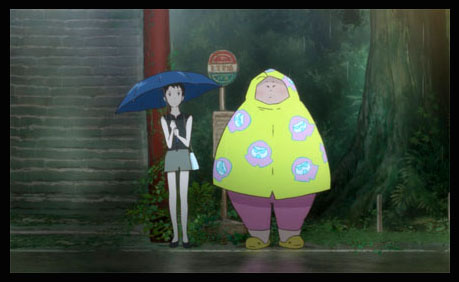
Annie Awards nominee Fortune Favors Lady Nikuko comes from director Ayumu Watabe (Children of the Sea). It’s fun and moving, with a strong mother-daughter relationship at its core. Lady Nikuko screened in theaters nationwide through Fathom Events last week and is still playing in select cinemas around the country. It’s also now on VOD and will be available on Blu-Ray, DVD and Digital July 19th. In this Animation Scoop Q&A, Watanabe discusses how family, food and a little bit of fantasy make-up the perfect recipe for a great movie. (This interview was done as an Email Q&A, translated and edited for length and clarity.)
Jackson Murphy: Kikuko is interested in what her mom was like before she was born — as well as her past lives. Are you interested in the idea of “past lives”, and how did you want to explore time in this film?
Ayumu Watanabe: There is a buddhist way of thinking “what goes around comes around”. You’ll be punished or rewarded depending on the good and the evil of your everyday behaviors. When I think about my upbringing and my current situation, I use that philosophy as a starting point or a guideline. Kikuko also uses that philosophy so that she can accept her unfortunate upbringing. And to think about her mother, Nikuko, and her devastating upbringing means a past even more hard to fathom. However, this is an optimistic way of thinking too; something good will happen after the bad. This is how they wish for happiness in their current life. There is frustration that happy-go-lucky Nikuko ends up being unhappy in her life. This also shows how Kikuko gives so much attention to her mother on a daily basis. I think using the past was an effective way to deeply depict the time that is shared between a parent and child.

JM: There is a distinct contrast between Kikuko and Nikuko’s personalities, behavior and clothing choices. At one point Kikuko wonders “Which one of us is the child?” What were your goals with presenting this contrast?
AW: Nikuko lives a free-spirited life just the way she is. That could be perceived as immaturity if maturity means having common sense. On the other hand, Kikuko is overtaken by common sense, and has a hard time unlocking her sense of self. She might give the impression of a mature person on the surface. It’s not about which is right or wrong. It’s about if they can accept, respect and be there for each other. And what’s most important is the fact that they are deeply connected. Even if there are quarrels (which is only natural), if you can find differences that you appreciate and respect, I think that would be an ideal relationship. That is “love”.
JM: Kikuko’s friendships with boys and girls are very complex. How did your childhood friendships inspire these elements?
AW: I personally also changed elementary schools twice, so I understand where Kikuko is coming from. Resigning yourself to not to expect anything from others, but also holding out big hope for a savior. This is not a special feeling, this is a rather normal feeling that you probably have in your heart as well. It would be wonderful if through this movie we could share with many others that changes of heart and self-discovery are possible for anyone.

JM: I love the aspect of the talking animals (and the nice reveal at the end). I feel like there’s great meaning behind the seagull saying, “Go Beyond!” Can you expand on this?
AW: It seems like you have a deep and accurate understanding of the film. That makes me really happy. The voice of the seagull was an invitation to Kikuko’s journey. It screams out of excitement for her unknown future, from the view of the seagull that flies the skies freely. It also brings the meaning of a “fledgling” just leaving the nest, and the nest is the sentimental feeling for one’s hometown. It indirectly points to Kikuko’s first time having an attachment to a place she has lived that she doesn’t want to lose, after spending so long moving from place to place.
JM: The food looks delicious. What is your favorite meal, and were you able to incorporate it into this film?
AW: I love all the food that appears in the film, but especially I love meat! “Misuji” is a rare, premium cut of beef, and I depicted it with the passion I had to try eating it. I was picturing the steak I had in the U.S. while drawing it. The U.S. has the best steak in the world! It is the food I love the most! Ahh… just by writing this answer I feel like I want to go back to the U.S. again!

JM: How do you hope families respond to this movie, especially since “family” is such an important theme in it?
AW: When the film ends and the lights are back on, I will be happy if the people in the audience look at the important people sitting next to them and smile at each other. It would be great if the audience gets the sense that they shared something together, having sat in their connected seats and shared time; that is actually what is worth a lot. Because what I wanted to portray in this film is clues to finding the love that is shining in ordinary, everyday life. If the audience, after watching this film, talks to each other about their views on this theme and the film in general, in their cars and at the restaurants, I would be absolutely happy.
- INTERVIEW: “Inside Out 2” Director And Producer On Pixar Sequel - April 16, 2024
- INTERVIEW: “Puffin Rock And The New Friends” And 25 Years Of Cartoon Saloon - April 10, 2024
- INTERVIEW: “Chicken For Linda!” Directors On Annecy Winning Feature - April 9, 2024


 June 8th, 2022
June 8th, 2022  Jackson Murphy
Jackson Murphy  Posted in
Posted in  Tags:
Tags: 






